White spots on gums may be a sign of leukoplakia, gum disease, candidiasis (fungal infections) or even more serious diseases such as STDs. The white dots on gums may be painful or painless but may need the attention of your dentist. Here are pictures, causes, and treatment for white patches, bumps, and lumps on gums.
White spots on gums pictures
What do white dots on gums look like? Most people will have small areas of inconsistent coloring on their gums. Some appear as white patches, white sores on gums or even bumps, marks or even lumps. Here are pictures to help you identify your symptoms.
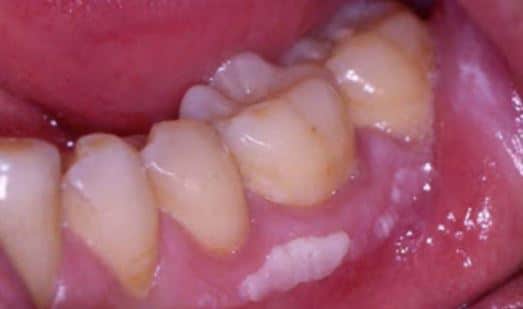
White patches on gums pictures.
What causes white spots on gums?
White spots on gums are usually the result of an irritation to the delicate tissues that are inside the mouth, especially the irritation that is resulting from a rough or ill-fitting denture, partials and any other dental appliances. Sometimes the white spots on the gums are a symptom of gum cancer.
- White spots on gums are a very common symptom of infection, trauma, malignancy, and any other underlying conditions as well as diseases.
- Mouth white patches may come from pathogens, like the bacteria, viruses, and fungi that inflame the lining of the mouth leading to swelling and ulcer formation.
- Ulcers most commonly happen on the inside part of the mouth but can also happen on the tongue as well as the lips, or in association with more generalized conditions, like cancer.
- Allergic reactions to any food and any other substances can lead to inflammation and development of the mouth white patches.
1. Leukoplakia
Leukoplakia normally affects the mucous membranes that are lining the inside of the mouth. During the leukoplakia, thick white spots on gums will develop. The white spots can also develop on the inside parts of cheeks, on the bottom of the mouth and, sometimes, on the tongue. You may not scrape leukoplakia white spots off the gums or any other areas of your mouth.
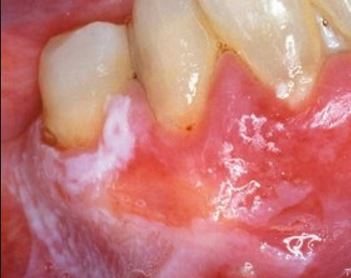
leukoplakia-white-patches-on-gums-due-to-smoking
- The dentist might suspect leukoplakia on examination; but, a biopsy is likely to be taken to rule out any other causes, like oral cancer.
- During the biopsy, a very small piece of a tissue from the lesion is removed and then examined in a lab. A numbing agent may be used so that an individual will not feel any pain.
Leukoplakia patches on gums are normally white in color but can also be gray in some other areas. The spots normally have an uneven shape and contain a slightly raised, firm surface. Contact with the spicy or even acidic foods may lead to pain. Sometimes the white spots can have a very fuzzy appearance, a condition that doctors call hairy leukoplakia.
Dentists have not established what leads to white spots on gums but they think the condition can be as a result of irritation. Rough teeth, dentures or even dental work can cause oral irritation in some other people, as can tobacco use and alcohol use. Research indicates that leukoplakia is most common among the elderly people.
2. Gum cancer
National dental organizations have warned severally that white patches on the gums may also be an indication of gum cancer.
Experts recommend you return to the healthcare professional for a re-evaluation and who can consider performing a biopsy in an event that the white spots on the gums do not heal within a period of two weeks. According to medical experts, oral cancer is among the most commonly diagnosed forms of the disease.
- The American Cancer Society has estimated that approximately 30,000 adults in the United States are having oral cancer.
In order to establish if the spots on the gums are cancerous, the dentist has to perform a biopsy. Treatments for oral cancer include options like surgery, radiation or even chemotherapy.
3. STDs, HIV
Hairy leukoplakia of the mouth is a very unusual form of leukoplakia (it is normally caused by the Epstein-Barr virus) which is seen only in individuals who are infected with HIV or have an AIDS-related complex.
It has fuzzy, white spots on gums, on the tongue and less frequently, elsewhere in the mouth. It can also resemble thrush, which is an infection that is caused by the fungus Candida which, in adults, usually happens if the immune system is not functioning properly. Thrush can also be one of the first indications of infection with the HIV.
4. Gum injury
Trauma to the mouth, gums or even teeth can result in the mouth white patches. Trauma-related cuts can also become inflamed, swell, or have the potential to develop into a mouth ulcer that is very white in appearance.
Ill-fitting dentures can also lead to mouth white patches that usually originate as injurious sores. Any other type of trauma to the mouth, lips or the tongue might result in the mouth white patches that are as a result of the inflammation and even the swelling that is around the site of injury.
5. Benign growths or bumps on gums
Most of the spots that require to be biopsied are not in any way cancerous. In these particular cases, the growth will likely be extracted.
White bumps on gums may appear as a result of tooth extraction, root canal procedures, and other dental pressure points.
6. Candidiasis and yeast infections
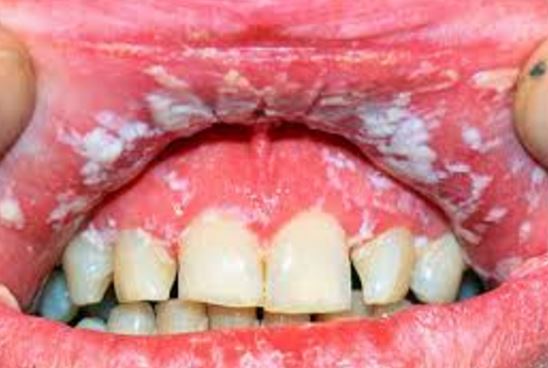
Candidiasis or oral thrush
Candidiasis is a yeast infection that is found in the mouth. According to the American Academy of Oral Medicine, the yeast might also grow on any other surface in the mouth, this including the gums. Thrush usually appears as white spots on gums in the mouth that looks like cottage cheese. Oral yeast infections are normally treated using anti-fungal medications.
7. Gum Irritation
In some other cases, white gums may be caused by an irritation. Common irritating culprits also include home teeth-bleaching treatments. In some other cases, even a chipped or even broken tooth can irritate the tissue enough to lead to white spots on gums.
8. Gingivitis
Gingivitis, as a very serious tooth problem, is one of the common cause of the small hard bumps. It might also lead to the gum swollen and even frequent bleeding, and you should go to visit a dentist urgently.
This gum disease begins with inflammation, which might also feel like the bump on gums, then it becomes worse if not treated. The bacteria slowly get rid of the surrounding tissue.
9. Gum ulcers
These ulcers normally appear inside the mouth and they might also be very painful. In some other case, they can have white spots on gums. Canker sores may be due to very few things, like the bad diet, food allergy, stress, and menstruation.
10. White spots on gums after tooth extraction
A bump on the gums normally appears after a tooth extraction. This can be a blood clot that sometimes forms there during the healing process, or even simply due to the irritation to the area, which can disappear within very few days.
Sometimes a simple irritation of a particular area can cause a bump on the gums. This often occurs if you have had something in the mouth that is pressing against a particular area, or if a person has a habit of moving the teeth in a way that they scrape against the opposite side gum. These irritations may also cause the immune system to form up white spots on gums to try to protect the area.
11. Smoking, chewing tobacco and drinking alcohol
Smoking is one of the single biggest cause of a mouth cancer, along with all too many other diseases. About forty years ago, there were several more men than women who were smoking. Today, smoking levels among the men have gone down by about 50%, and by 20% among the women – but that still leaves one in six women and men smoking. Both smoking and alcohol are associated with throat cancer also.
The role of smoking in the development of lung cancer as well as cardiovascular disease is well documented. It also has a very crucial part to play in many other diseases and lesions in the mouth; the most common being gum disease.
12. Dental implants or dentures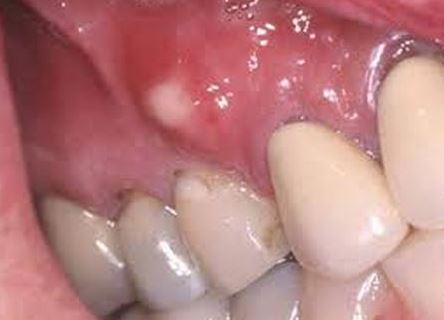
The chance of dental implant failure is very common among the smokers than among non-smokers, and even the gum disease that is around the implants in those people who smoke is also very much prevalent.
When teeth whitening products get on the gums, they then turn white and the surface eventually sloughs off. Although not very pleasant to look at, it is a very minor form of damage that normally heals in less than one day.
Most of the teeth whiteners are made up of peroxide. When you place a peroxide on the skin to clean a cut, the surface turns normally white. The speed and even severity of this white effect are much dependent on the strength of the peroxide.
When having a professional whitening in the dental office, the customized trays as well as the special materials that are used to protect the gums from the effect. Over the counter whitening products make use of a one-size-fits-all method and so the peroxide product more frequently gets to the gum surface.
- When making use of the whitening strips, be sure to use them only to the tooth surface thus leaving a little space above the gums.
- When using the trays, place only enough whitening gel to the coat the surfaces of the teeth without trying to squeeze out onto the gums.
- These tricks will assist to avoid this kind of minor damage.
13. Teething in babies
Teething often causes the baby discomfort, restlessness, as well as irritability. As the roots of the teeth try to grow, they push the edges of the teeth through the baby’s gums. The effects are normally most dramatic with the first teeth, as the sensation is new to the baby, and with the molars, due to the large size.
White gums that are around teeth usually happen after any tooth extraction. It is normally of no concern unless the spot of the gums that usually turns white is very large.
However, you’d better call the dentist if there are any complications after tooth extraction procedure is done. Gum tissues can also turn to white spots on gums because of various reasons. For example, lack of blood supply can lead to a buildup of the dead gum tissues.
In a majority of the patients, the dead tissue goes away within very few weeks. In some other patients, white gums after the tooth extraction can develop because of dry sockets. After tooth extraction, a blood clot is then formed in the empty tooth socket. The blood clot can also get dislodged causing the occurrence of dry socket.
White spots on gums of baby
The white bumps present on the upper gum in this infant are Bohn’s nodules. The exact etiology is unknown, but they are thought to arise from remnants of the dental lamina or from heterotrophic salivary glands. Present either on the lateral aspect of the gum (as seen here) or on the periphery of the palate, these nodules are a benign finding and will disappear with time.
When the nodules are large, they are sometimes mistaken for teeth, but the position on the exterior surface of the upper gum is inconsistent with teeth. When natal teeth occur, they erupt from the alveolar ridge, and typically occur in the mandibular gum.
Some infants are born with one or more teeth. They are called natal teeth. Some babies have teeth emerge into the mouth within the first 30 days of life. These are called neonatal teeth. Because these are primary teeth, not extra any other teeth, it is a perfect idea to keep them if possible. However, sometimes a natal or neonatal tooth may have to be extracted. Extraction can be best if they are likely to come loose or even when they interfere with the feeding or importantly irritate the tongue or lip leading to white spots on gums.
Related symptoms
Ulcers, sores, or even the tender areas of the mouth might signify a number of health conditions. Some of the conditions might affect more than just the teeth as well as the gums.
For instance, mouth wounds that don’t heal might sometimes show diabetes. People who have diabetes have a very difficult time of healing than those who don’t have diabetes.
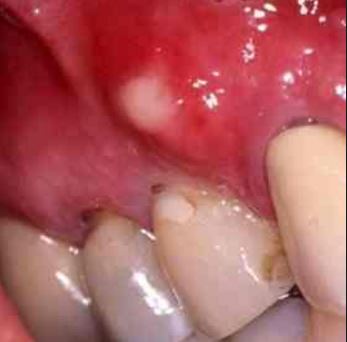
A white bump on upper gums.
- Seeing blood in the sink or on the toothbrush every time after you brush teeth can be a sign of a health issue. Healthy gum tissue shouldn’t bleed unless brushed too aggressively.
The gums, hold the teeth in place. They’re in charge of creating a barrier between the tooth roots, and blood vessels, and the foods as well as the drinks that you consume. You may also lose a tooth or teeth if you don’t have healthy gum tissue.
- Sometimes the bad breath is as a result of the garlic-filled dinner that you just ate or an indication that you are required to drink more water. The dentist can provide tips to keep bad breath at bay even if you don’t have signs of dental decay.
- You can expect much sensitivity due to dental procedures like cavity fillings or even crown placements. Sudden, unexplained changes that are due to sensitivity imply that you should call your dentist. Increased temperature sensitivity is a sign of a dental abscess, which is a bacterial infection of the tooth or even the gum area that is next to a tooth root.
Painful white spot on gums
Cancer that is appearing on any part of the mouth is known as mouth cancer. Some of the common signs of mouth cancer are a sore that do not heal, formation of the lump, white spots on gums or even a red colored patch, white gums that is around teeth, loosening of the teeth, pain or stiffness in jaw, pain while chewing or even swallowing as well as sore throat.
The exact cause of the mouth cancer is not known but there are some other conditions that normally increase the risk including the tobacco usage, heavy alcohol use as well as excessive exposure of the lips to the sun. HPV or human papillomavirus, which is a sexually transmitted virus, might also lead to mouth cancer.
Treatment of the disease entirely depends on the location as well as the extent of cancer and may include an appropriate combination of the surgery, radiation therapy and chemotherapy.
Note that people whose immune system is very much compromised can also develop the white spots on gums. Besides, also do remember that the pale pink gums are normally considered very healthy. Unhealthy white gums near the teeth are not very uniform and may also happen on the tongue as well as the inner cheeks.
Big or small white dots on gums
Coxsackievirus infection might also cause many small cold-like signs and blisters on the mouth, mouth gums, hands, and feet.
White spot on gum above tooth or around teeth
Pemphigus is a disease that leads to blisters on the skin and the sores on the mucous membranes of the body.
Treatment for white patches, sores on gums
Stopping smoking and reducing the alcohol consumption can assist to clear up the white patches in the mouth, as well as reducing the chances of developing the mouth cancer.
If you’re thought to have an increased risk of having mouth cancer, leukoplakia may be surgically extracted to ensure the abnormal cells so that they don’t later become cancerous.
Treatment of the white spots on gums entirely depends largely on the specific cause of the problem. In some other cases these are very harmless and will disappear on their own, but in other cases, the white spots on the gums may be an indication of a serious problem like an infection or the early stages of cancer in need of immediate attention.
It is better to keep a close eye on the spots and observe if they start to heal without any intervention, or if they seem to be getting much worse. If you have got any doubts, it is better to have a physician observe the spots to help you to make an informed decision.
Treating spots on gums that is related to cancer may be difficult and can require surgery, chemotherapy, and all other treatments. The sooner you identify and even treat any potentially serious problem, the better the chances for a positive outcome.
Regardless of the treatment that you receive, it’s crucial to have the mouth more regularly examined by a dentist or even a suitable specialist so as to ensure that the condition isn’t progressing.
- Treatment for the leukoplakia, if required, involves removal of the source of irritation. For instance, if leukoplakia is brought about by a rough tooth or even an irregular surface on a denture, the tooth can be smoothed and the dental appliances repaired. If leukoplakia is brought about by smoking, you may be asked to minimize or even stop smoking or any use of other tobacco products
- Leukoplakia is normally harmless, and lesions clear in very few weeks or months after the source of irritation is extracted. If elimination of the source of irritation is in any way ineffective in reducing of the leukoplakia, the lesion can be required to be surgically removed. The lesion may be removed either by the general dentist or even by an oral surgeon. Hairy leukoplakia needs to be treated using an antiviral medication.
- In some other cases, white spots on the gums show up as a side effect of the tooth whitening treatments. When this occurs, the spots will then appear very suddenly after the whitening treatment has been much completed, due to some of the chemicals that are getting onto the gums. In this very situation, you don’t need to do anything so as treat them, and the spots may fade and disappear on their own within three to four days.
- If you have had some injury to the mouth, the white spots on the gums may be due to abscesses or even the ulcers. These are related to the infection and might usually need some type of treatment, usually in the form of antibiotics. You might assist to soothe irritated or even infected spots by use of a mild salt water solution, swirling it around in the mouth and over the injured area.
- White spots on gums may also due to yeast infections like the ones that are caused by Candida Albicans, which is a condition that should be brought to the attention of the physician. Fungal infections are not harmful but they might be a sign of an underlying problem, so it is better not to ignore them. Normally antifungal medication can resolve the problem.
- Persistent white spots on the gums might also be the result of leukoplakia, which is a precancerous skin condition that might affect the gums, cheeks, or other mouthparts. Smokers, drinkers, as well as those who chew tobacco, are at high risk for this type of cancer, but it might affect anybody. The white spots brought about by the condition may not appear much when they first begin, but they might develop into a very serious, life-threatening problem if ignored.
How to Maintain Good Oral Health
While treating the white gums that are around teeth, it is crucial to maintaining a very good oral health. Some of the tips that can assist to maintain good oral health care as indicated:
- 1. Avoid Soda
Drinking soda regularly is bad for the teeth. The citric acid as well as the phosphoric acid that are in soda soften the tooth enamel thus making the tooth more prone to developing of the cavities. Replace soda with water. Crushed mint leaves or even berries or sliced citrus fruits might be added to water so as to flavor it.
- Brush Regularly
Tooth decay is normally accelerated by the sugar which fuels the acidity as well as the bacteria that is in the mouth, causing a formation of a plaque on the gums and teeth. Cut down on sugary meals and make it a habit to brush and floss the teeth after every snack or even meal.
Further references
- Recognizing the Warning Signs of 5 Dental Health Issues: http://www.healthline.com/health/dental-health-warning-signs
- Oral Care: http://www.webmd.com/oral-health/guide/oral-health-symptoms-types
- How Do I Treat White Spots on Gums: http://www.wisegeekhealth.com/how-do-i-treat-white-spots-on-gums.htm
- What Causes White Spots On Baby Teeth?: http://www.colgate.com/en/us/oc/oral-health/life-stages/infant-oral-care/article/what-causes-white-spots-on-baby-teeth-1015
- Your Infant’s Mouth: http://www.colgate.com/en/us/oc/oral-health/life-stages/infant-oral-care/article/your-infants-mouth
- White Gums Around Teeth: http://www.newhealthadvisor.com/White-Gums-Around-Teeth.html
- What to Do when Gums Peel and Blister After Teeth Whiting: https://www.realself.com/question/gums-peel-blister-after-teeth-whiting
